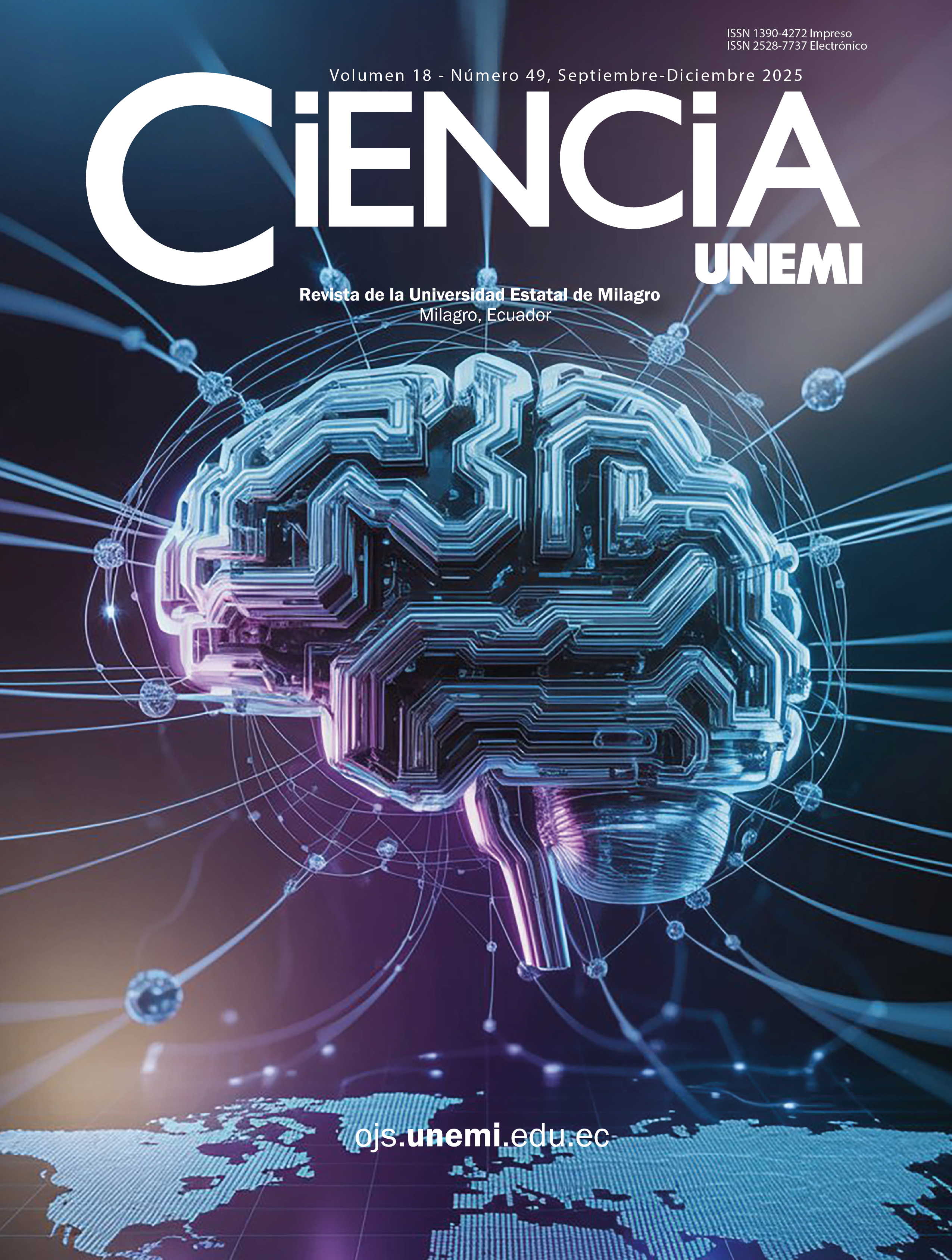El impacto del aprendizaje de una segunda lengua en el desarrollo de la creatividad intelectual y mental
DOI:
https://doi.org/10.29076/issn.2528-7737vol18iss49.2025pp106-111pPalabras clave:
Adquisición de una segunda lengua, bilingüismo, flexibilidad cognitiva, pensamiento creativoResumen
El aprendizaje es un proceso cognitivo que involucra diversas funciones mentales y brinda la oportunidad para que emerja la creatividad en la mente y el pensamiento del niño. En este sentido, el desarrollo del campo mental del niño durante el proceso de aprendizaje de una segunda lengua genera destellos de creatividad que estimulan y potencian su pensamiento. El presente estudio tuvo como objetivo explorar el papel del aprendizaje de una segunda lengua en el fomento del desarrollo intelectual y creativo en la infancia. La investigación se llevó a cabo mediante un enfoque analítico-descriptivo basado en la revisión de literatura científica. Los resultados evidencian que el aprendizaje debe sustentarse en materiales educativos adecuados para favorecer el desarrollo de la creatividad intelectual del niño. Además, se identificó que la adquisición de una segunda lengua promueve la flexibilidad cognitiva, la formación de la identidad y la creatividad, dependiendo de la intensidad de la exposición y la práctica
Descargas
Referencias
Altma, H. B. (1972). Individualizing the Foreign Language Classroom: Perspectives for Teachers. Rowley, Mass: Newbury House.
Bialystok, E., Craik, F.I.M., Luk, G. (2008). Lexical access in bilinguals: Effects of vocabulary size and executive control. Journal of Neurolinguistics. 21(6):522–538. https://doi.org/10.1016/j.jneuroling.2007.07.001
Bialystok, E. (2005). Consequences of Bilingualism for Cognitive Development. In J. F. Kroll & A. M. B. de Groot (Eds.), Handbook of bilingualism: Psycholinguistic approaches (pp. 417–432). Oxford University Press.
Blumenfeld, H.K., Marian, V. (2007). Constraints on parallel activation in bilingual spoken language processing: Examining proficiency and lexical status using eye-tracking. Language & Cognitive Processes. 22(5):633-60. http://dx.doi.org/10.1080/01690960601000746
Barak, L. (2017). Developmental psychology, translated by Yahya Seyed Mohammadi, Volume 2, Tehran, Arasbaran Publications.
Coggins, P. E., Kennedy, T. J., & Armstrong, T. A. (2004). Bilingual corpus callosum variability. Brain and language, 89(1): 69–75. https://doi.org/10.1016/S0093-934X(03)00299-2
Colzato, L. S., Bajo, M. T., van den Wildenberg, W., Paolieri, D., Nieuwenhuis, S., La Heij, W., & Hommel, B. (2008). How does bilingualism improve executive control? A comparison of active and reactive inhibition mechanisms. Journal of experimental psychology. Learning, memory, and cognition, 34(2): 302–312. https://doi.org/10.1037/0278-7393.34.2.302
Doustizadeh, M., Seyedi Fazlollahi, N. (2022). The effect of creativity and autonomy on individual identity in german language teaching - investigating the role of educational games on students' independent learning behavior. Foreign Language Research Journal, 12 (2): 19-36. https://doi.org/10.22059/jflr.2022.328893.908
Geravand, K. (2024). Exploring the relationship between creative problem solving and reading comprehension among Iranian EFL students. School education in the third millennium, 2(1): 33-44. doi: 10.22034/jsetm.2024.455471.1033
Ghonsooly, B., Showqi, S. (2012). The effects of foreign language learning on creativity. English Language Teaching. 5(4):161-67. https://doi.org/10.5539/elt.v5n4p161
Kharkhurin, A. V. (2009). The role of bilingualism in creative performance on divergent thinking and invented alien creatures tests. The Journal of Creative Behavior, 43(1): 59–71. https://doi.org/10.1002/j.2162-6057.2009.tb01306.x
Leikin, M., Tovli, E., Malykh, S. (2014). Bilingualism and creativity in early childhood. Creativity Research Journal. 3(2):54-63. https://doi.org/10.5430/elr.v3n2p54
Müller, N., & Hulk, A. (2001). Crosslinguistic influence in bilingual language acquisition: Italian and French as recipient languages. Bilingualism: Language and Cognition, 1: 1–21. https://doi.org/10.1017/S1366728901000116
Pallant, J. (2010). SPSS survival manual: A step by step guide to data analysis using the SPSS program [Rezaei A, Persian trans]. 4th ed. Tabriz: Forouzesh.
Poarch, G.J., Bialystok, E. (2015). Bilingualism as a model for multitasking. Developmental Review. 35:113–24. https://doi.org/10.1016/j.dr.2014.12.003
Rössler, W., Hoff, P. (2004). Psychiatrie zwischen Autonomie und Zwang. Berlin: Springer Verlag.
Salahi, A. A. (2016), Identity, Tehran: Protected Scroll.
Salahi, A.A., Kabiri, M. H., Cheraghi, A., Mohammadi Kalheri, S., Tonkar, N. (2018). Adolescence and identity, Shahid Sattari University of Aeronautical Sciences and Technology.
Yousefi, R., Soleimani, M., & Ghazanfariyanpoor, S. (2017). Comparison between switching and creativity among bilingual and monolingual children. Journal of rehabilitation, 18(1): 1-12. http://dx.doi.org/10.21859/jrehab-18011
Wiseheart, M., Viswanathan, M., Bialystok, E. (2014). Flexibility in task switching by monolinguals and bilinguals. Bilingualism: Language and Cognition. 19(1):141-146. https://doi.org/10.1017/s1366728914000273
Descargas
Publicado
Número
Sección
Licencia
Derechos de autor 2025 CIENCIA UNEMI

Esta obra está bajo una licencia internacional Creative Commons Atribución-NoComercial-SinDerivadas 4.0.
Los autores pueden mantener el copyright, concediendo a la revista el derecho de primera publicación. Alternativamente, los autores pueden transferir el copyright a la revista, la cual permitirá a los autores el uso no-comercial del trabajo, incluyendo el derecho a colocarlo en un archivo de acceso libre.

















